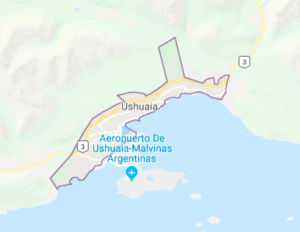Ushuaia, Argentina, the southernmost, civilized city, located along the Argentine-Chilean border, surrounded by the Martial mountains, the Parque Nacional Tierra del Fuego, and the Beagle Channel, Ushuaia is anything but a sleepy town. The city itself is a thriving port, the streets are lined with colorful houses, restaurants, bars, hotels, and hostels overlooking the snowcapped mountains and icy waters of Beagle Channel. The views are spectacular in Ushuaia. The air is clean, crisp, and fresh.

Whether you are coming to Ushuaia to hike the amazing trails of the National Park or sail around Beagle Channel, or to take a day trip to the nearby attractions such as the Falkland Islands or Martillo Island, where you can see the Gentoo penguins, there are a couple of things you should know before planning a trip here; Ushuaia is NOT cheap, and the weather can be very gloomy.

After all, Ushuaia is called, “Fin del Mundo”, which means the end of the world. Logistically getting goods (food, clothing, toiletries, etc.) to the end of the world is going to be expensive. Also, getting in and around Ushuaia is also expensive. We took Bus-Sur from Punta Arenas, Chile to Ushuaia, Argentina.
A one-way ticket cost $35,000 CLP ($54 USD/ person). The trip itself was 11 hours long, and we made 4 stops in total. The first stop was a restroom break/ food break and to place our bus onto a barge to bypass a body of water, then there were 2 additional restroom breaks and one border patrol stop to enter Argentina (from Chile). The buses are very comfortable, spacious, and clean, have a USB port so you can plug in your electronics, and have a restroom on board. Note, you must book online and bring a printed copy of your ticket prior to this trip to Ushuaia.

The bus also only leaves Punta Arenas on Mondays, Wednesdays, and Fridays and on Tuesday, Thursday, and Saturday from Ushuaia. We chose to take a bus to save money seeing as how a round-trip airline ticket costs $466,700 CLP ($700 USD/ person). Getting around within Ushuaia is fairly easy as the city is only 9 square miles long and you do not mind walking up and down steep hills.
There are taxis and local buses if you prefer to not walk or if there is inclement weather. However, if you would like to travel outside of the city limits, buses and taxis are not cheap. We took a bus to the Parque Nacional Tierra del Fuego and a round-trip ticket cost $400 ARS ($26 USD/ person) to travel 12km (7.5 miles). Normally we would have simply walked this distance, but the terrain itself was very rough.

Travel Tip: Whether you are staying in a hostel, hotel, or Airbnb, privacy and security are key. You may not always have a lockable door for your room or, even if you do, you want to double down on the security. We use these door stoppers to make sure unwanted people, or dogs, are not trying to enter our room at night. It’s also great for a shared shower situation. It is small to pack and will give you peace of mind. Find this and other tips on our Travel Tools page.
We took an afternoon to trek the Parque Nacional Tierra del Fuego (Tierra del Fuego National Park). There are 4 main trails to choose from, each varying in level of difficulty and distance you will trek. The trail we chose to walk was called Costera Trail. The trail itself was 8km (5 miles) in length, was estimated to take approximately 4 hours to walk, was rated “moderate” level of difficulty. We chose the trail based on its description… “shoreline travels through evergreen beach and winter’s bark forests”.
The description, although sounded magical, cannot even begin to describe or put into words just how dramatically beautiful the landscape is once you are surrounded by it in person. From the crystal clear waters of the lakes and rivers, the lush, green, quiet forest that swallows you whole, to the snowcapped mountain peaks that jut into the skyline, the Patagonian wilderness that surrounds you is full of life, colors, and a calm stillness that is unlike anywhere else in the world. The cost to enter the park was $350 ARS per person ($22.50 USD).
As for the weather, it is very windy and wet. Ushuaia averages about 146 days of rain per year. When it is not raining, it is one of the most beautiful places on earth. When the sun is shining you are able to see off in the distance for what seems like forever. You can feel the pureness of the air with each breath you breathe in.
The air feels clean, crisp, and fresh. When it is raining, there is somewhat of a haze or fog which makes it hard to see the mountains and the cold, harsh, icy winds come in off the ocean making it hard to enjoy the outdoors. Summer in Ushuaia is from November to March and the average temperature is 50F during the day and low 40’s at night. I would recommend bringing an insulated jacket, scarf, and hat during the summer. I wore my Patagonia Nano Puff Jacket, Patagonia Capilene Thermal Weight Scull Cap, and my Lululemon Vinyasa Scarf. During their winter, the temperature can get to 0F.

There are several places to stay in Ushuaia (hotels, hostels, resorts, etc.). We stayed at an Airbnb for 4 nights in Ushuaia. In doing our research, hotels can cost up to $3,100-$5400 ARS per night ($200-$350 USD) and the hostel reviews we read through were nothing to be desired; typically costing $310-$460 ARS per bed/ per night ($20-$30 USD).
There are several restaurants and pubs located in Ushuaia. As I stated before, things in this city are NOT cheap. A typical lunch (a salad or a sandwich) will cost you $250 ARS per person ($16 USD), dinner for two at a local pub (pizza and a beer or two) will cost you $800 ARS ($53 USD), and dinner for 2 at a local Italian restaurant (appetizer, main course, and wine) will cost you $1,200 ARS ($80 USD). Black coffee at a cafe will cost you $35 ARS ($2.30 USD) and a microbrewed beer at a local pub will cost you $100 ARS ($6.60 USD).
On average, if you eat breakfast, lunch, and dinner, plan on spending approximately $777 ARS per person/ day on food ($50 USD). As you can see this can add up quickly, especially if traveling together as a couple and especially since there are very limited options seeing as how you cannot leave Ushuaia to dine at a nearby town to save money. There are several grocery stores in town however, we were unable to check prices as we arrived at the store as it was closing at 1400 on a Sunday.
Prior to coming to Ushuaia, we struggled with the question, “how long should we stay in Ushuaia?” I personally do not prefer the colder weather and told my husband that I wanted to stay in Ushuaia for the 4 nights/ 5 days, the shortest amount of time possible, so that we could catch the next available Bus-Sur back to Punto Arenas. I also thought to myself how much hiking/ trekking can one possibly do in Patagonia?
Although our trekking experience in Tierra del Fuego National Park was one of the most scenic and beautiful walks I have ever experienced (besides Iguazu Falls), I am very glad that we decided to stay for just the 5 days between the exorbitant prices and the windy, rainy weather. I am very glad that we came, I am very blessed that we had the opportunity to see the beautiful land of Patagonia, and I am very excited to get to our next, warmer destination. As Paul Theroux said, “Travel is glamorous only in retrospect.”

Leave a Reply